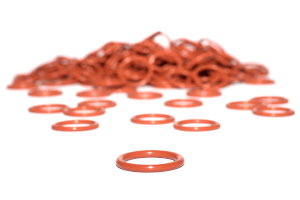SILICONE O-RINGS | MATERIALS SIMPLY EXPLAINED
What are SILICON O-rings?
Silicone O-rings are particularly suitable for use in contact with sensitive products, for example in medical or food technology.
The excellent heat resistance and low-temperature suitability make VMQ a reliable O-ring material for many applications.
The separately managed fluorosilicone rubber FVMQ behaves similarly to VMQ, but has improved resistance to mineral oil products. This closes the most important gap in VMQ’s durability profile.

Feature | Value |
|---|---|
ISO designation | VMQ |
Trade names | Silicone, Silicone |
Chemical name | Vinyl-Methyl-Silicone |
Media resistance | Medium media resistance |
Temperature resistance | -60°C to +200°C |
Standard color | Red |
Standard hardness | 70 Shore A |
Industries | Food, gas/water installation |
Production | Compression molding and injection molding |
Tolerances | DIN ISO 3601 |
Durability | 10 years |
REQUEST SILICONE O-RINGS QUICKLY AND EASILY?
Almost any dimension available
Over 10,000 FKM dimensions available from stock
Offer received in record time
No minimum order values or minimum quantities
#1 The 5 most important advantages of SILICON O-rings
1. superior low-temperature resistance
2. special hot air resistance
3. good physiological properties
4. resistance to vegetable and animal oils and fats
5. insensitivity to weather influences
VMQ O-rings retain their technological properties over a very wide temperature range.
From the lower application limit at -60 degrees to the maximum temperature of 200 degrees in hot air, the sealing properties vary only slightly. VMQ stands out from the other O-ring materials, particularly in the low-temperature range. Special qualities from VMQ are even suitable for temperatures up to 200 degrees.
The physiological properties of VMQ should also be emphasized. The material hardly interacts
with other media and so undesirable product influences from the sealing elements can be ruled out.
This is one of the decisive arguments for the use of VMQ O-rings in medical and food technology production systems. Silicone is also odorless and tasteless.
The fact that animal oils and fats are part of the resistance profile also helps VMQ O-rings to be widely used in the food sector.
A comparison of the most important O-ring materials
Material | Temperature resistance | Chemical resistance | Elasticity |
|---|---|---|---|
NBR | -30°C to +120°C | Low | High |
HNBR | -30°C to +150°C | Medium | High |
EPDM | -45°C to +150°C | Medium | High |
SILICONE | -60°C to +200°C | Low | High |
FKM (VITON) | -25°C to +200°C | Medium | High |
FEP coated | -60°C to +200°C | High | Medium |
PTFE | -250°C to +250°C | High | Low |
FFKM | -40°C to +340°C | High | High |
#2 The 3 most common areas of application for SILIKON O-rings
ELECTRICAL ENGINEERING
VMQ O-rings are not only found in large production plants or gas supply systems. They can also be found in many electronic devices.
The most important factor here is the stable electrical properties of the material. For example, seals must not become electrically charged in some areas. This applies, for example, to seals with fuel contact or drive belts.
VMQ O-rings can be made conductive or insulating and are therefore suitable for applications with special requirements in terms of electrical properties.
Food and pharmaceuticals
The production of food, beverages and medicines is subject to special safety regulations. After all, these products regularly enter the human organism directly.
O-rings that come into contact with these products must therefore be physiologically safe. For example, the American FDA (Food and Drug Administration) sets requirements for the extraction of material components from the sealing elements.
VMQ O-rings are available in many FDA-compliant grades, so they meet the requirements for minimum product impact. This also applies to compliance with other industry-specific regulations such as those of the BfR (Federal Institute for Risk Assessment), 3A Sanitary Standards or USP.
GAS supply and gas consumption
Applications in the oil and gas sector are among the most safety-critical areas of use for sealing elements.
While VMQ gaskets are not resistant to mineral oil-based products, they are suitable for use in gas supply and gas consumption facilities. In Germany, approval by the DVGW (German Technical and Scientific Association for Gas and Water) is decisive for this.
The technical requirements are defined in DIN EN 549. Alternatives to VMQ are O-rings made of FKM, HNBR or NBR can be considered.
#3 What is the media resistance of SILIKON O-rings?
Resistant to:
– Weather and ozone
– Aliphatic engine and gear oils
– Glycol-based brake fluids
– Hydraulic fluids
– Oils and fats
Not resistant to:
– Water vapor above 120°C
– Strong acids and alkalis
– Silicone oils (caution during assembly)
Demanding thermal applications make up the application profile of VMQ.
However, the temperature suitability must always be checked in conjunction with the respective contact media. Silicone O-rings are resistant to temperatures above 200 degrees in air. If water is used as the medium, VMQ O-rings can be used permanently at temperatures of up to 100 degrees.
The O-rings are also resistant to aliphatic engine and transmission oils and glycol-based brake fluid. Another technical fluid on the resistance list for silicone O-rings are flame-retardant hydraulic fluids.
VMQ owes its widespread use in the food and beverage industry to its resistance to oils and fats of vegetable and animal origin.
VMQ shows weaknesses in contact with water vapor above 120 degrees. This also acts as a limiting factor in steam sterilization in food processing production facilities.
Acids, alkalis and fuels are also exceptions to the media resistance. As silicone O-rings have limited durability in contact with silicone oils and greases, assembly requires particular care. Common silicone-based lubricants used to facilitate assembly can damage the O-rings.
In general, the influence of incorrect media causes VMQ to lose hardness and tensile strength. The material swells unlike many other elastomers.
#4 What is the temperature resistance of SILIKON O-rings?
Silicone O-rings have a temperature resistance of -60°C to +200°C.
Even in standard qualities, silicone O-rings cover a very wide temperature range. The low-temperature suitability of the material stands out in particular.
With similar heat resistance, VMQ O-rings retain their sealing properties in even more extreme cold than EPDM O-rings. The good low-temperature flexibility of the material is decisive for this.
The fact that the sealing-relevant properties of silicone O-rings are only slightly temperature-dependent is shown, for example, by the compression set.
It remains low even at high temperatures, which indicates that the elastic properties are retained. Even after being subjected to pressure at high temperatures, silicone O-rings return to their original shape to a large extent in order to close the sealing gap. However, this applies to VMQ in air.
In contact with steam, the compression set of VMQ increases significantly. This permanent deformation reduces the sealing effect and limits the area of application. This applies not only to silicone, but also to FKM O-rings which perform similarly well in hot air.
#5 What are the mechanical properties of SILIKON O-rings?
1. High abrasion
2. Low tensile strength
3. Low elongation
The mechanical properties of VMQ are weak compared to other gasket materials.
This is particularly evident in the poor abrasion behavior. Mechanical stress due to movement in the sealing system quickly causes material loss on the O-ring. This abrasion can contaminate the contact media on the one hand and lead to a loss of the sealing effect on the other.
In this context, the low extrusion resistance of VMQ poses a challenge. If high pressure is exerted on silicone O-rings under operating conditions, these are easily pressed into the sealing gap facing away from the pressure.
This can lead to peeling of the O-ring. The unfavorable abrasion behavior also excludes the
dynamic use of silicone O-rings. The tensile strength and elongation at break are also at a low level.
This requires special care when designing the installation spaces and fitting silicone O-rings.
#6 What do I have to consider when designing the groove of a SILICON O-ring?
1. Groove design according to DIN 3771 Part 5
2. Reduce the sealing gap by 50% compared to other elastomers
3. Ensure minimum compression of the cross-section of 6%
4. Secure silicone O-rings against excessive pressure with a support ring
5. Select manufacturing processes with a special focus on tolerances
Since silicone O-rings have weaknesses under high pressure loads, the groove design must take this into account.
The sealing gap must therefore be smaller than with other elastomers. This reduces the risk of crevice migration. Support rings can be used as additional aids. When machining the components, designers should pay attention to low tolerances.
can be used to avoid large local sealing gaps.
What do I need to consider when fitting a silicone O-ring?
1. Provide insertion slopes between 15 and 20 degrees
2. Deburr drill holes
3. Plan sharp edges with a minimum radius of 0.1 to 0.3 mm
4. Use a suitable assembly aid (mineral oil-based)
5. Avoid twisting the O-ring during assembly
Apart from the general installation recommendations, silicone O-rings should not be installed using silicone oil or grease in order to avoid media attack.
In addition, due to the low elongation at break, excessive expansion during installation must be avoided at all costs.
#7 Further important information on SILICON O-rings
Finally, we would like to answer a few questions that we are frequently asked in everyday life.
#7.1 What is included in the silicone O-ring range?
You can find our complete range of silicone O-rings here:
#7.2 Is there a data sheet for the silicone O-rings?
You can easily view the data sheet for our SILICONE O-rings directly on our website and download it if you wish.
#7.3 What is the silicone O-ring temperature resistance?
In principle, silicone O-rings are permanently resistant from -60°C to +200°C.
It is important to note that the temperature resistance only applies to the medium “air”.
#7.4 Are silicone O-rings food-safe?
Yes, all our silicone O-rings are food-safe.
This means that the O-rings are approved in accordance with the guidelines of the FDA (Food and Drug Administration).
“I am convinced that we should share our knowledge with the world. I hope I have been able to answer all your questions. If you have any further questions, please feel free to contact us at any time. We will be happy to help you.”

Lord of the O-rings
Author of the sealing academy
